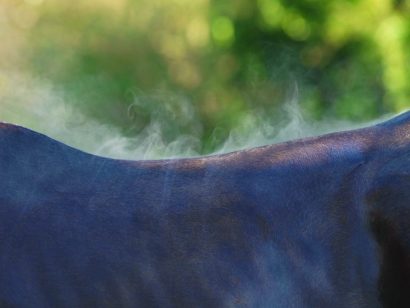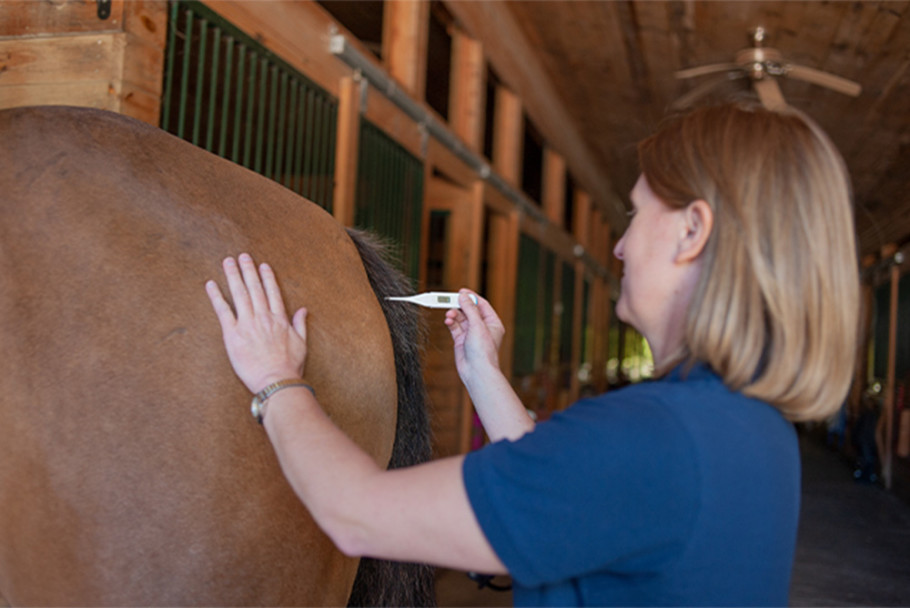Heat Stress in Horses: How Hot is Too Hot to Ride?
Updated December 15, 2023 | Reviewed By: Joan Maree Hinken, DVM, CVA, CVSMT

What is Heat Stress in Horses?
During the summer when the sun’s rays are their strongest or throughout the year in warm climates, these beautiful beach days can quickly turn dangerous for your horse. With rising temperatures and unrelenting humidity comes a risk of heat stress and heat stroke for your horse.
Your horse experiences heat stress when they are unable to thermoregulate to cool themselves down through sweat and the evaporation of sweat. Heat stress or exhaustion can lead to heat stroke, a life-threatening condition.
Causes of Heat Stress and Heat Stroke in Horses

Horses produce heat in their body in two ways - through exercise and digestion.
Researchers at the University of Guelph found that horses are 3 - 10x more susceptible to the negative effects of heat stress than people. Part of this is because they are much larger with a higher percentage of active muscle than humans during exercise. Horses also generally produce more sweat, but far less of that sweat is able to evaporate, so they are less effective in cooling down.
Circumstances and causes of heat stress in horses include:
- High temperatures and/or humidity
- Being outside in direct sunlight
- Inside a poorly ventilated barn or trailer
- Excessive exercise
Horses that are very muscular or are overweight will have a harder time handling the heat and are more at risk in warm conditions. Also, be sure to keep an eye on foals and senior horses on hot days since both age groups can be more prone to heat stress.
Symptoms of Heat Stress and Heat Stroke in Horses
On steamy summer days, pay attention to your horse for any of these signs and symptoms of heat stress:
- Temperature of 102° F to 105° F
- Excessive sweating or a lack of sweat (anhidrotic horses)
- High respiratory rate (over 10-12 breaths per minute, flaring nostrils, rapid breathing) or high heart rate that doesn’t improve with rest
- Hot skin to the touch
- Signs of dehydration (tenting of skin, pale and tacky mucous membranes, sunken eyes, dry feces, lack of appetite, lethargy)
- Weakness, stumbling
- Refusal to work or a reduced level of performance
If heat stress is not properly treated right away, it can quickly lead to heat stroke. Signs of heat stroke in horses include:
- Temperature above 105° F. At this temperature, blood supply to the muscles beings to shut down. This can progress to turn off blood supply to the intestines and kidneys, and finally to the brain and heart.
- High respiratory rate and heart rate persists.
- Refusal to work or eat.
- In extreme conditions, horses can collapse and even convulse or go into a coma.
What Temperature is Too Hot to Ride a Horse?
Although a specific horseshow, race, or other equestrian event may decide on a temperature limit at which their activity may be modified or canceled, there is no hard and fast rule among the horse community about when it’s too hot to ride. One of the reasons is that temperature alone isn’t a great indicator of how well a particular horse may deal with the heat.
The Problem with Thermometers
Dry bulb thermometers are great for measuring the ambient air temperature, but unfortunately, they don’t give you the whole picture. The next measurement that’s useful to know is the relative humidity since horses (like humans) rely on sweating to keep their bodies cool but sweat doesn’t evaporate as well when there’s already moisture in the air.
The U.S. National Weather Service came up with the “heat index” as a guide. But there are still more factors to take into account! The military devised the more comprehensive Wet-Bulb Globe Temperature Index, which combines temperature, humidity, wind, and solar radiation since air movement and sunshine can dramatically alter not only how hot it feels but also a body’s ability to release heat.
AccuWeather’s RealFeel accounts for cloud cover, sun intensity, and the angle of the sun in addition to the other components of temperature to come up with a number that is much more realistic. For your and your horse’s sake, use one of these formulas that are based on more than just the absolute temperature.
Guidelines for When it’s Too Hot for Your Horse
When the temperature (Fahrenheit) is added to the humidity (%), you will have these heat stress effects and risks.
- Below 130 = Most horses can thermoregulate
- Over 150 = Hard for most horses to keep cool, may affect the horse’s ability to sweat
- Over 180 = High risk – horses are unable to cool themselves properly, dangerous conditions
Tips to Prevent Heat Stress in Horses

Here are some practical tips to help you make the call of “how hot is TOO hot” for equestrian activities:
- Horses that already live where it’s warm and humid are at least somewhat acclimated to the environment. If a horse has recently shipped in from a cooler, drier region though, it can take 21 days for them to get used to the new climate. Experts advise keeping the workload light as horses adjust.
- In addition to getting used to a hotter, stickier environment, horses also have to get used to the workload. If a horse is already fit going into summer, he’s more likely to tolerate the heat better. If not, add exercise gradually and perhaps back off a bit when the numbers soar.
- Sweat (aka evaporation) is the horse’s primary means of cooling himself, but the other methods of heat dissipation—convection, radiation, and even conduction—play a role too. Find a cool breeze and seek shade when the heat seems overpowering. Offer horses a drink before, during, and after exercise and apply continual cool water hosing until the horse’s temperature approaches normal.
- Avoid hauling in a trailer when it’s extra toasty. As the sun rays heat things up, plus reduced air movement around the horse, it can get very warm inside a rig very quickly. If you must haul, go early in the morning or late in the evening (even overnight) when it’s coolest and the sun’s rays are less intense.
- Likewise, if a horse must be worked, choose an early or late time instead of the middle of the day so that the temperature, humidity, and sun aren’t at their strongest levels.
- Add salt and other electrolytes to the feed or to a second bucket of water. Normal equine feedstuffs (hay, pasture, grain) don’t meet horses’ daily requirements for sodium. Plus, when it’s hot and they’re sweating out a lot of sodium and chloride, horses can become even more deficient in these and other minerals.
- When turning your horse out to pasture, make sure they have a shaded area where they can escape the sun’s rays, or try turning out in the evening, overnight, or in the early morning hours when the sun is not as strong. Once you bring your horse inside, give them some relief with a stall fan to help circulate the air.
Maybe on those really hot, humid days where there’s no wind, no cloud cover, and the sun is beating down, it’s time for an easy groundwork review, an extra grooming session, or a thorough tack cleaning!
Video on Exercises for Your Horse When it’s Hot
What to do if Your Horse Overheats
Hopefully before any signs of heat stress occur you are able to recognize that your horse isn’t dealing well with the heat and humidity and have checked his rectal temperature. While the critical core temperature in the horse is unknown, readings above 106° F are extremely serious.
With the normal temperature of the horse being 99.5° F to 100.5° F, anything above 102° F or 103° F may mean back off. If not, more serious signs may occur such as low blood volume and electrolyte abnormalities, tying up, colic, kidney failure, nervous system consequences, and even collapse and death.

Treating Heat Stress and Heat Stroke in Horses
In such severe situations, call your veterinarian and try to stop your horse’s core temp from continuing to climb. Immediately discontinue work and start cooling the horse by moving him out of direct sunlight. You should repeatedly apply cool water (even cold water or ice water if available) starting at the legs and working your way all over the horse’s body, including the head. If possible, get a fan on the horse and frequently offer him small amounts of water to drink.
When the veterinarian arrives, he or she may administer intravenous (IV) fluids and/or oral fluids via a stomach tube. Both sets of fluids will contain electrolytes to help restore the horse’s internal balance of these minerals which are lost in sweat. Additional therapy may be given depending on the horse’s signs.
Key Takeaways
While it’s important to be careful on hot, humid days, that doesn’t mean you can’t enjoy time with your horse! Be mindful of the signs that your horse is becoming overheated and call your vet immediately if your horse is unable to cool himself. Take it slow and remember that when you’re feeling hot, your horse is hotter.